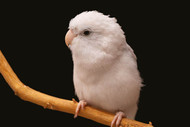Parrotlets Fact Sheet
Posted by Parrotlets Fact Sheet, Parrotlets Diet, Parrotlets Training, Parrotlets Origin, Parrotlets Advice, Fact Sheet on 9/1/2024
Thanks to Rosemary Low for this interesting article about Parrotlets.
Common names:
Celestial or Pacific Parrotlet
Scientific name:
Forpus coelestis
Adult length:
about 5in (12-13cm). As they are a similar size to a Budgie, find items for them here.
Adult weight:
25-30g
Status in wild:
Common, especially in drier regions.
Origin:
of genus: Mexico and South America(Green-Rumped introduced to Caribbean.)

Acquired when young, these sparrow-sized Parrots can make wonderful pets, especially for people with small homes. The following can be applied to all members of the genus except that the Yellow-faced (F.xanthops) is larger, rarer, threatened in the wild and not usually kept as a pet.
Personality
As variable as in any other Parrot. Colette Outhier wrote of her Spectacled Parrotlet: ?He is dazzling and clever, curious and stubborn, playful and trusting, almost always sweet, usually cuddly and definitely now the ruler of my heart? (International Parrotlet Society,Sept/Oct 2003).
Very social, he would sit in the window chattering with the birds outside for hours at a time. He was very playful, swinging from toy to toy, busily shredding the destructible but never chewing a hole in her clothing.
Hand-reared young
Celestial Parrotlets are usually weaned at six to seven weeks and can go to their new home at eight weeks. Spectacled Parrotlets might not be weaned until eight weeks.
Training young birds
This is no different to training a larger Parrot, a fact that might be overlooked due to their small size. Parrotlet owner Mike Warren wrote: ?It?s our responsibility to let them know what is acceptable behaviour. My advice to new owners is to go slow, let the bids get accustomed to you and their new environment before challenging them with your flesh.
Avoid situations where they will bite you. Don?t let them on your shoulder until they?re finger trained and respond to ?step up?. Find out what makes them tick, develop a strategy for rewarding good behaviour?: (International Parrotlet Society Vol VII, issue II, page 13).
Diet
Parakeet mixture, dry and sprouted; spray millet and seeding grasses. All the usual fruits, plus strawberries; greenfoods (young dandelion leaves, seeding dock, spinach, broccoli, etc), cooked pulses, cooked frozen peas and sweet corn and par-boiled carrot can be offered ? but many Parrotlets are reluctant to sample some of these items.
Other food is available here.
Vocalisations
A shriek when frightened but otherwise not noisy. Males can mimic human speech in a very small voice. As in Budgerigars, most females are poor mimics or do not ?talk? at all.
Warnings
*Male Parrotlets when rearing young or feeding a female, may look after their family so well that they starve themselves and die. Keep a watch on breeding males, if necessary checking that they are not losing weight.
*When two Parrotlets are kept in a cage, there is a danger that one will kill the other. Get the biggest cage you can afford here.
*Breeders should be aware that many Parrotlets are very sensitive to nest-box inspection and can abandon eggs or chicks as a result. If possible, nest-box cameras should be installed.
*In decades of breeding Parrots, the only species that ever mutilated a chick?s foot after I close-ringed it was a Parrotlet.
*Mexican Parrotlets are said to be very susceptible to stress, especially when moved to a new location.
Other species in aviculture ? Status in wild
Spectacled (F. conspicillatus) Common, perhaps increasing.
Blue-winged Parrotlet (F. xanthopterygius) Widespread and locally common.
Green-rumped (F.passerinus) Common or locally common.
Mexican (F.cyanopygius) Fairly common. Specially protected in Mexico as an endemic species.
Society
International Parrotlet Society, founded in 1992.
Colour Mutations
These are numerous in the Celestial. One of the most popular and beautiful is the blue.
Sexing
This is possible in the nest. In adult Celestials the male?s shade of green is much brighter; on forehead, cheeks and throat it is more yellow-green. Primary and secondary coverts and lower back are deep cobalt blue.
In the female these areas are green. The rump is turquoise (cobalt in male). In most species the males have the rump blue and the female?s rump is green.

In the Spectacled Parrotlet the male?s blue rump feathers and blue eye streak do not appear until the first moult but the colour in the wings is indicative of gender. The blue of the rump starts to show at about three months of age.
They moult into adult plumage at five to six months.
Choose from hundreds of Parrotlet products here.

